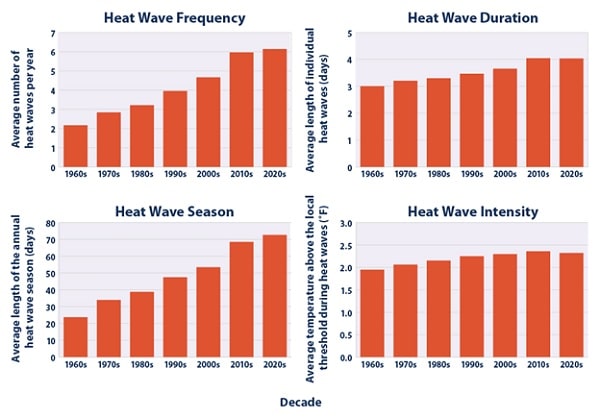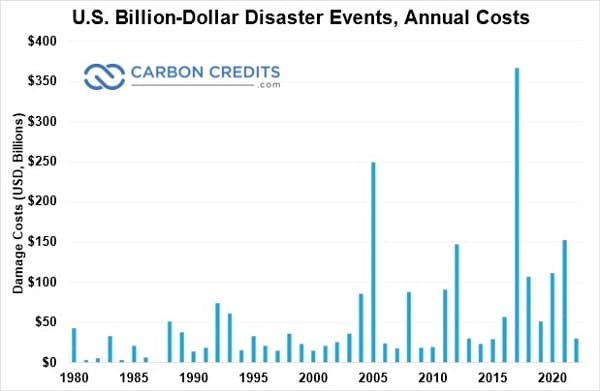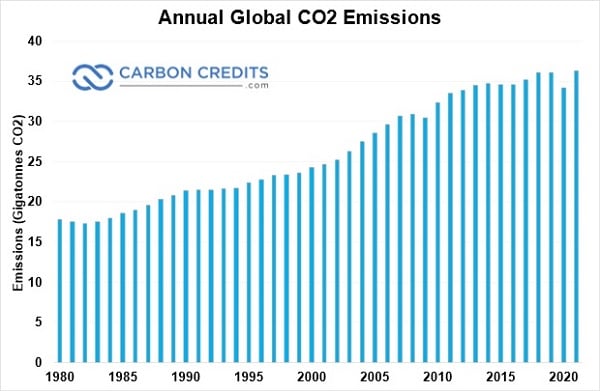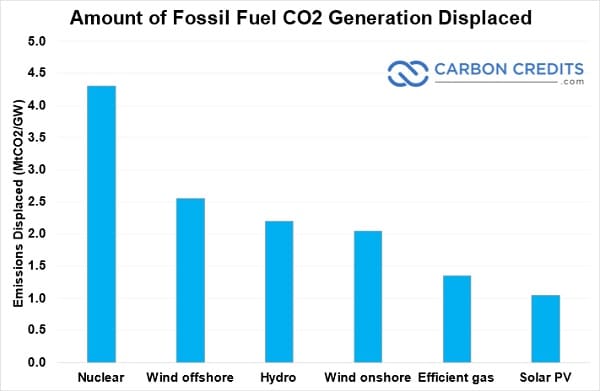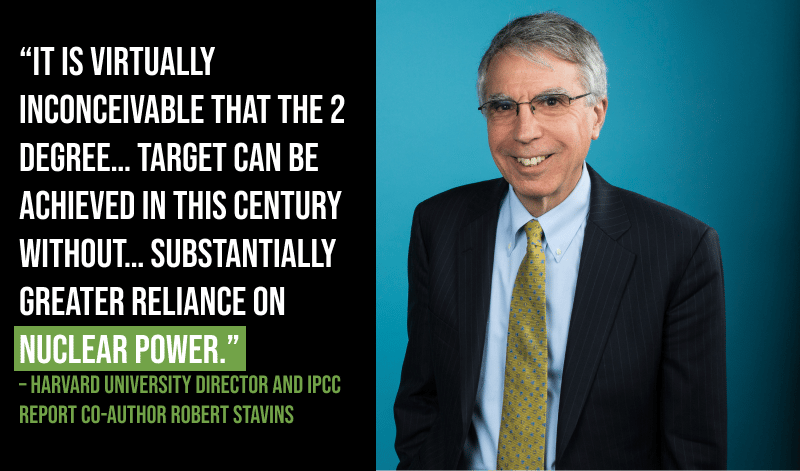Here’s what they’re not considering: fossil fuels produce two-thirds of electricity in the world.
And it has waste, too. Only it’s not measured in mere tons, like nuclear waste.
- The waste from coal and oil electricity is measured in giga tons— that’s billions of tons.
And its waste is far more harmful to the environment on a mass scale than nuclear waste.
In fact, the waste from oil and coal is causing the single greatest existential threat of our time: climate change.
CO2 emissions have turned our earth into a hothouse—one from which we might not escape.
Heat waves are hotter, happen more often, and last longer than they used to.
Fires are roaring across countries… rivers are drying up… hurricanes and floods are levelling cities.
This climate change crisis will lead to the loss of lives and is costing trillions.
To avoid the worst effects of climate change, like the disappearance of sea ice, the collapse of ecosystems, and global weather refugees, it’s going to take more than just a decrease in emissions.
We must fully decarbonize the entire global electricity sector, eliminating the 36 GT of CO2 spewed into the atmosphere every year.
And we’ve got less than three decades to do it before a reversal becomes impossible.
To achieve complete decarbonization, countries have spent the last decade “going green”, targeting “net zero” and slashing carbon-emitting sources.
Yet despite the efforts of most of the developed world, CO2 emissions have stubbornly kept increasing.
Emissions By Any Other Name
In fact, in the past forty years, we’ve only seen three years with emissions decreases:
- once during the Global Financial Crisis,
- once during COVID,
- and a tiny 0.1 GT decrease in 2015.
In 2021, immediately following the pandemic, global CO2 emissions snapped back to their highest level in history… with the biggest emissions increase in history.
Scenarios from the Intergovernmental Panel on Climate Change (IPCC) show that the chances of limiting the global temperature increase to 1.5 degrees are getting extremely slim.
How did we get so far off track? One simple reason:
- The world is playing a massive cup-and-balls trick that nets the world zero gains in the fight on climate change.
Take California, for example.
It’s requiring 100 percent of all energy sold to be clean by 2045. And to get there, and to a net zero target, it’s cutting a perfectly good carbon-free source of energy: nuclear.
In fact, it’s cut nuclear power by 50 percent over the past decade. Guess what made up a large chunk of the difference…
Natural gas.
Now—by its own estimate—California needs to deploy wind and solar at five times its average pace… for the next twenty years straight, just to meet its 2045 goal.
Here’s the thing. Nuclear electricity production is already emissions free. So even if California successfully replaced all of its carbon-free nuclear energy with wind and solar, there would be zero emissions reduction.
It’s not just California. Michigan shuttered a huge nuclear plant, killing with it the hopes of a net zero or zero-carbon state economy by 2050.
It’s a trend around the world, spurred on by Fukushima in 2011.
Before the incident, Japan planned to reduce its emissions by 20 percent from 1990–2020.
Instead, it nearly doubled its use of coal and natural gas from 2009–2013—using it for more than 90 percent of its electricity generation. As a result, Japan’s CO2 emissions shot up 15 percent.
Germany followed Japan’s lead, announcing in 2011 that it would shut down all of its nuclear plants and replace them with renewables.
It was a lie. Germany’s nuclear power has been almost entirely replaced by natural gas.
And that’s why emissions refuse to fall…
“We’re Cooked”
Far from reducing emissions—or even keeping them the same—for every reactor that is forced to shut down, CO2 emissions rise by 5.8 MT a year.
- That’s the equivalent of filling an NFL stadium to the brim with gas, and setting it on fire.
We’d need to install solar panels on one million homes just to make up for shuttering a single reactor.
Nuclear reactors are extremely efficient, low-carbon sources of energy. In fact, it doesn’t matter whether it’s replacing coal or natural gas…
- Nuclear is nearly 100 percent more effective than any other energy technology at reducing CO2 emissions.
There is simply no achieving net zero without nuclear.
That’s why a letter from scientists at Carnegie, MIT, and Columbia said:
“Continued opposition to nuclear power threatens humanity’s ability to avoid dangerous climate change.”
Or MIT scientists and NASA researchers…
Nuclear “will make the difference between the world missing crucial climate targets or achieving them.”
A report from the United Nations Economic Commission for Europe made it as clear as possible:
“International climate objectives will not be met if nuclear power is excluded.”
Here’s the reality:
- The only countries in the world that have broken the fossil fuel addiction and transitioned to low-carbon power have done so with the aid of nuclear.
That’s why more than a dozen countries have said that nuclear power will play a crucial role in reducing their emissions.
Right now, a giant U-turn is happening around the world to add nuclear—fast—to achieve net zero by 2050.
The question is: How much nuclear does the world need to stay alive?
Nuclear Civilization, or No Civilization
The International Energy Agency says global nuclear capacity needs to increase by 130 percent by 2050 to meet climate change goals.
Their net-zero emissions scenario sees one new plant being added every ten days within a decade.
“In today’s context . . . nuclear power has a unique opportunity to stage a comeback.”
– IEA Executive Director Fatih Birol
The IPCC goes even further. In the eighty-nine scenarios they considered, nuclear generation increases by an average of 250 percent.
That means roughly 1,000 new nuclear plants built in the next twenty-five years.
The Harmony Programme proposes about 1,250 new nuclear plants, to allow for retirements. That would provide 25 percent of electricity around the world, all carbon-free.
Some say we don’t have time for nuclear anymore—”It takes too long to build.” They’re wrong.
South Korea is building plants in four years, and they’ve got eight under construction right now.
If a tiny country can do that, imagine what a mobilization of the entire world would bring about.
An average of twenty reactors per year started up globally from 1975–1985.
A single nuclear reactor produces about 9 TWh of energy a year, and the world uses about 24,000 TWh of energy a year.
- That means if we had kept building the same old plants at the same old pace . . . we would have hit net-zero around 2000.
As it stands, we have thirty years left. And right now, fifty-six reactors are under construction.
For context, that’s more than the net addition of nuclear power since 1985.
More than 300 reactors are planned—and counting.
Avoiding a total climate meltdown is the hardest challenge the world has ever faced.
But with nuclear, we’ll beat it.

